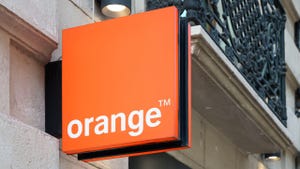
SES hooked up with manufacturing partner Boeing on Tuesday for the formal unveiling of O3b mPower, a next-gen, global connectivity platform that will ultimately comprise a constellation of 11 high-capacity medium Earth-orbit (MEO) satellites.
That new constellation will be made to work in conjunction with SES's existing fleet of geosynchronous (GEO) satellites and original O3b MEO satellites – all tied together with a direct connection to the Microsoft Azure cloud.
Figure 1:  O3b mPOWER satellite hardware is inspected on the Boeing high-bay floor in El Segundo, California.
O3b mPOWER satellite hardware is inspected on the Boeing high-bay floor in El Segundo, California.
(Photo source: Boeing)
Orbiting at a height of about 8,000 kilometers or about 5,000 miles, each O3b mPower satellite will support hundreds of gigabits per second of capacity, be equipped with up to 5,000 steerable beams, and support latencies in the neighborhood of 150 milliseconds.
The satellites will also sport digital "adaptive resource control" technology that enables SES to dynamically steer beams to provide broad coverage or get a grip on usage spikes by dedicating beams and capacity to individual users, Steve Collar, SES's CEO, said at an event held from a Boeing "clean room" where the satellites are being built.
Together, the new 11-satellite constellation will target near-global coverage (about 96% of the world's population) and provide about 1 Tbit/s of capacity. O3b mPower won't play in the residential broadband game, but will instead complement SES's focus on services for the telecom, mobility (including cruise ships, commercial shipping and jets), government and enterprise (including oil and gas and mining) markets.
"With mPower, we go from ten beams per satellite to 5,000 beams per satellite. It's the first terabit constellation," Collar said.
Jim Chilton, SVP of space and launch at Boeing, said the O3b mPower is the result of a new 702X design and the use of an "integrated payload array" that vastly reduces the satellite's hardware part count. Each O3b mPower satellite comprises fewer than 400 hardware components, compared to 4,000 or more for a traditional satellite, according to SES.
Chilton likened it to making the jump from a cathode-ray tube television to a new flat panel. "Probably five generations in one leap is how I would characterize it," he said.
Boeing is preparing to send the first three O3b mPower satellites to its environmental testing lab. Collar said the goal is to launch the three together by the end of the year, and to follow with the launch of three more in Q2 2022. SES intends to launch the remaining satellites in the O3b mPower constellation throughout 2022 and 2023. All of SES's new satellites will be sent into orbit via SpaceX Falcon 9 rockets.
Update: SES followed up to clarify the launch schedule for the O3b mPower constellation. It is as follows:
Q4 2021: 3 satellites
Q1 2022: 3 satellites
2H 2022: 3 satellites
2H 2024: 2 satellites
Connecting with the cloud
That O3b mPower constellation will eventually connect to seven ground stations to provide global coverage and work in tandem with SES's GEO-based constellation. The full system will have full access to the cloud by connecting to Microsoft's Azure network. SES is building its O3b mPower gateways at the site of Microsoft's largest data centers.
"We don't have communications between the satellites, because frankly we don't need them," Collar said. "The idea is to combine [the GEO and MEO constellations] and integrate them into a seamless network so our customers don't even necessarily need to worry about which satellite they're on and which constellation they're on."
Tied into an extended partnership with Microsoft, Microsoft will also be an O3b mPower customer, tapping in to provide additional resiliency and redundancy of its systems. Microsoft will use SES's classic MEO constellation to provide connectivity today and migrate to O3b mPower next year.
Other announced O3b mPower customers include Carnival Cruises, Orange and iSat Africa.
LEOs have their place
SES's approach with the new MEO constellation will support much lower latencies than GEO-based systems, but not to the degree that low Earth-orbit (LEO) systems, such as the one underpinning SpaceX's Starlink service, can provide.
"We love LEO. We are a multi-orbit operator, so we think there are advantages in each of the orbits," Collar said, noting that LEO-based systems require many more satellites for coverage and are generally more technologically complex.
Consumer broadband, he added, represents the "sweet spot" for LEO-based platforms, as they provide a "shell of connectivity." But consumer broadband is not a market that SES is particularly interested in, Collar said.
Related posts:
— Jeff Baumgartner, Senior Editor, Light Reading
About the Author(s)
You May Also Like











